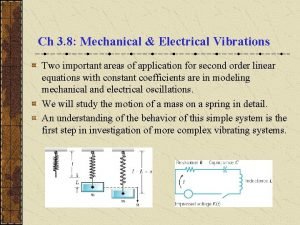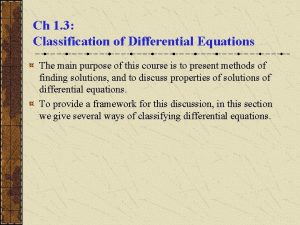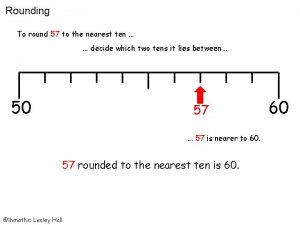Differential Equations and Applications math 151 Instructor Kun







- Slides: 7

Differential Equations and Applications (math 151) Instructor: Kun Xu (徐昆) TA: Changqiu JIN (晋长秋) Text Book: Boyce and Diprima, Elementary Differential Equations and Boundary Value Problems, 8 th Ed. , Wiley

Ch 1. 1: Basic Mathematical Models; Direction Fields Differential equations are equations containing derivatives. Derivatives describe rates of change. The following are examples of physical phenomena involving rates of change: Motion of fluids Motion of mechanical systems Flow of current in electrical circuits Dissipation of heat in solid objects Seismic waves Population dynamics Tsunami A differential equation that describes a physical process is often called a mathematical model.

Example 1: Free Fall (1 of 4) Formulate a differential equation describing motion of an object falling in the atmosphere near sea level. Variables: time t, velocity v Newton’s 2 nd Law: F = ma = m(dv/dt) net force Force of gravity: F = mg downward force Force of air resistance: F = v upward force Then Taking g = 9. 8 m/sec 2, m = 10 kg, = 2 kg/sec, we obtain

Example 1: Sketching Direction Field (2 of 4) Using differential equation and table, plot slopes (estimates) on axes below. The resulting graph is called a direction field. (Note that values of v do not depend on t. )

Example 1: Direction Field Using Maple (3 of 4) Sample Maple commands for graphing a direction field: with(DEtools): DEplot(diff(v(t), t)=9. 8 -v(t)/5, v(t), t=0. . 10, v=0. . 80, stepsize=. 1, color=blue); When graphing direction fields, be sure to use an appropriate window, in order to display all equilibrium solutions and relevant solution behavior.

Example 1: Direction Field & Equilibrium Solution (4 of 4) Arrows give tangent lines to solution curves, and indicate where soln is increasing & decreasing (and by how much). Horizontal solution curves are called equilibrium solutions. Use the graph below to solve for equilibrium solution, and then determine analytically by setting v' = 0.

Equilibrium Solutions In general, for a differential equation of the form find equilibrium solutions by setting y' = 0 and solving for y : Example: Find the equilibrium solutions of the following.













